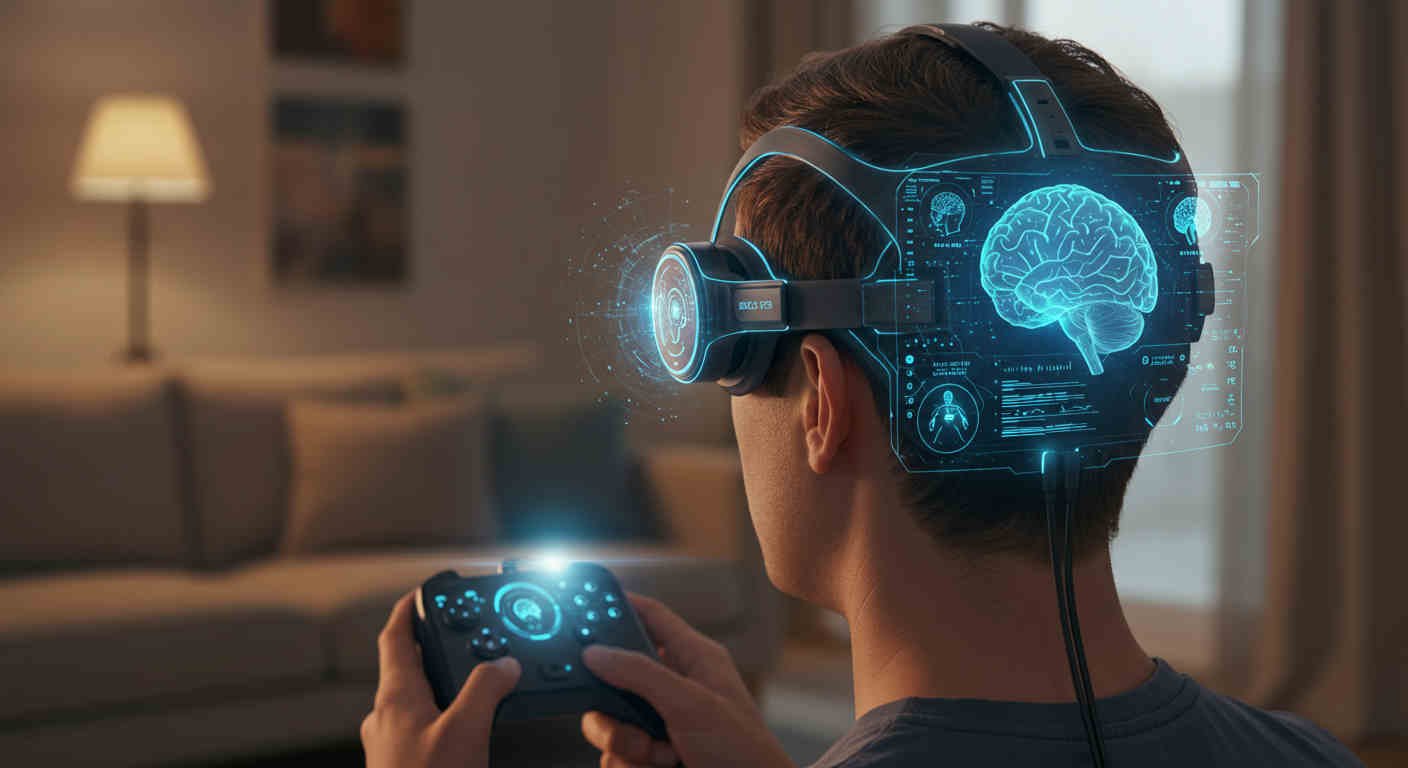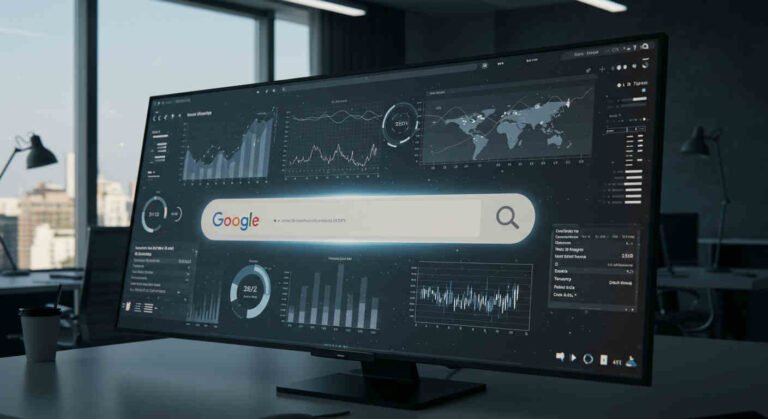Brain Games Unlocked: The Science of Neurotech in Everyday Life
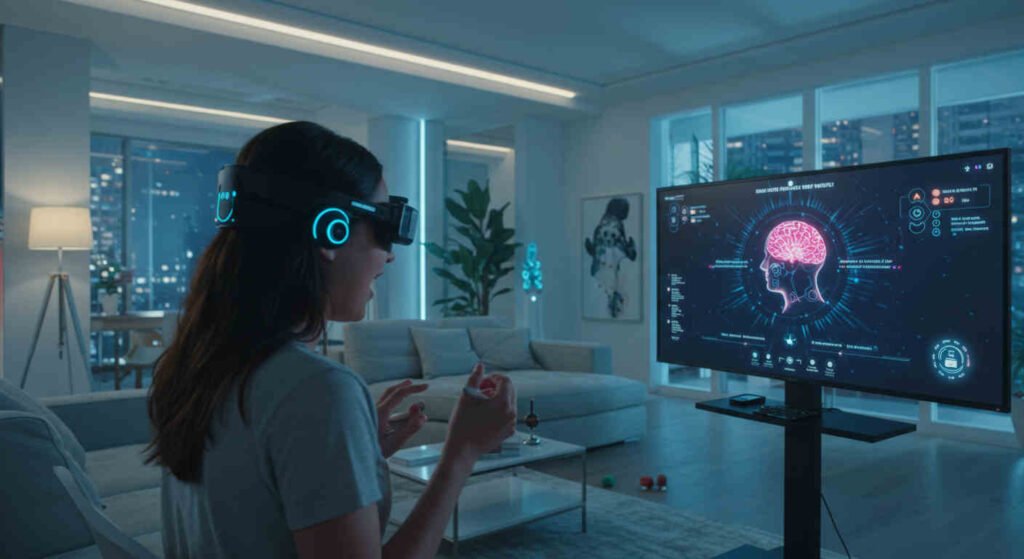
Table of Contents
Holy smokes! See how neurotech’s changing daily life in 2025 with brainy gadgets and mind-blowing apps. Dive into the future!
Wowza, Neurotech’s Knocking on Your Brain’s Door!
Picture this: you’re sipping coffee at your favorite spot, and a tiny gadget on your head’s chatting with your brain, helping you focus like a laser or chill like you’re on a beach. That’s neurotech in 2025, folks, and it’s like a magic key unlocking your mind’s secrets! Back in the day, brain science was locked in labs, all serious and stuffy. Now? It’s popping up in your earbuds, games, and even your morning jog. Neurotech’s like a trusty sidekick, making life sharper, calmer, and way more fun. So, grab a snack, get comfy, and let’s spill the tea on how this brainy tech’s sneaking into your everyday routine, from work to play and everything in between.
How Neurotech Got Its Groove On
From Lab Coats to Living Rooms

Way back when, brain tech was like a sci-fi flick—big machines, white coats, and words nobody could pronounce. Think EEGs in the 1920s, clunky as a Model T, measuring brain waves with a hum. By the 2000s, brain-computer interfaces (BCIs) started tiptoeing out, letting folks move cursors with their thoughts. Fast-forward to 2025, and neurotech’s gone from nerdy to normal, like smartphones did. Now, it’s in sleek headbands, snappy apps, and even your watch, helping you think clearer or sleep better. Ain’t it wild how something so brainy got so easy?
Why Brains and Tech Are Besties

Your brain’s like a super-busy city, with 86 billion neurons firing signals faster than a text thread. Brain games unlocked: that’s neurotech in 2025, the mapmaker reading those signals with a buzz and turning ‘em into actions. It uses stuff like EEG (brain wave readers), fNIRS (blood flow trackers), or implants to listen to your noggin. In 2025, it’s cheap, portable, and user-friendly, like a game controller for your mind. Just like quantum computing’s cracking tough puzzles, neurotech’s decoding your brain to make life a breeze.
The Nuts and Bolts of Neurotech
Reading Your Brain’s Chatter
Neurotech’s like a mind reader, picking up your brain’s electric vibes. EEG headsets, like Muse S, catch waves with a soft whir, telling if you’re stressed or zoned in. Others, like fNIRS gear from Kernel, watch blood flow to see what parts of your brain are partying. These gadgets are so light, you barely notice ‘em, yet they’re spilling your brain’s secrets like a chatty pal. In 2025, they’re as common as Fitbits, tracking your mind’s ups and downs.
Talking Back to Your Brain
Some neurotech doesn’t just listen—it talks back with a zap. Transcranial magnetic stimulation (TMS) uses magnetic pulses to nudge your brain, like a gentle poke to boost mood or focus. Others, like neurofeedback apps, train your brain to chill by showing real-time wave patterns. It’s like your brain’s getting a pep talk, learning to stay calm or sharp as a tack.
Hooking Up to Gadgets
Brain-computer interfaces (BCIs) are the rockstars here, letting your thoughts steer tech. In 2025, Neuralink’s implants let paralyzed folks type with their minds, while non-invasive BCIs, like NextMind’s, let you control games with a thought. It’s like your brain’s got a remote control, flipping channels on your devices with a click.
AI’s the Brainy Sidekick
AI’s the secret sauce, making sense of brain data faster than you can say “whoa.” Machine learning crunches signals, spotting patterns like a hawk. In 2025, AI in tools like Emotiv’s headsets predicts when you’re distracted, nudging you back on track. It’s like having a coach in your corner, cheering your brain to victory.
Neurotech in Your Daily Grind
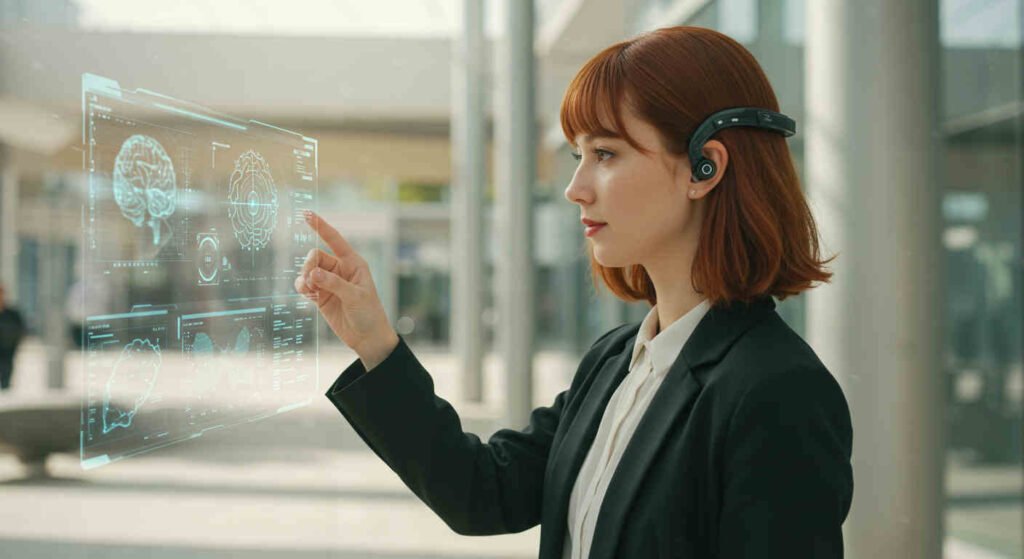
Work Smarts That Shine
Ever zone out in a meeting? Neurotech’s got your back. Headsets like Focus@Will use neurofeedback to keep your brain humming, boosting productivity by 20% in 2025 studies. Companies like Google use ‘em for brainstorming, making ideas spark like fireworks. It’s like a coffee shot for your mind, keeping you sharp as a razor all day.
Learning That Sticks
Students are loving neurotech, too. Apps like Brain.fm pair music with brain wave nudges, helping you study like a champ. In 2025, schools use EEG caps to tweak lessons, making math feel like a game. Test scores are up 15% in pilot programs. It’s like your brain’s got a tutor whispering, “You got this!”
Fitness with a Brainy Twist
Your gym routine’s getting a neurotech makeover. Wearables like Halo Sport zap your motor cortex with a tingle, boosting muscle memory. Athletes in 2025, from runners to yogis, train 25% faster with these gadgets. It’s like your brain’s a coach, yelling, “One more rep!” to your muscles.
Chilling Out Made Easy
Stress got you frazzled? Neurotech’s like a warm hug. Muse S headbands guide meditation with a soft hum, calming your brain in minutes. Apps like Calm use neurofeedback to tailor sessions, cutting anxiety by 30% in trials. It’s like a vacation for your mind, no plane ticket needed.
Neurotech in Playtime and Fun
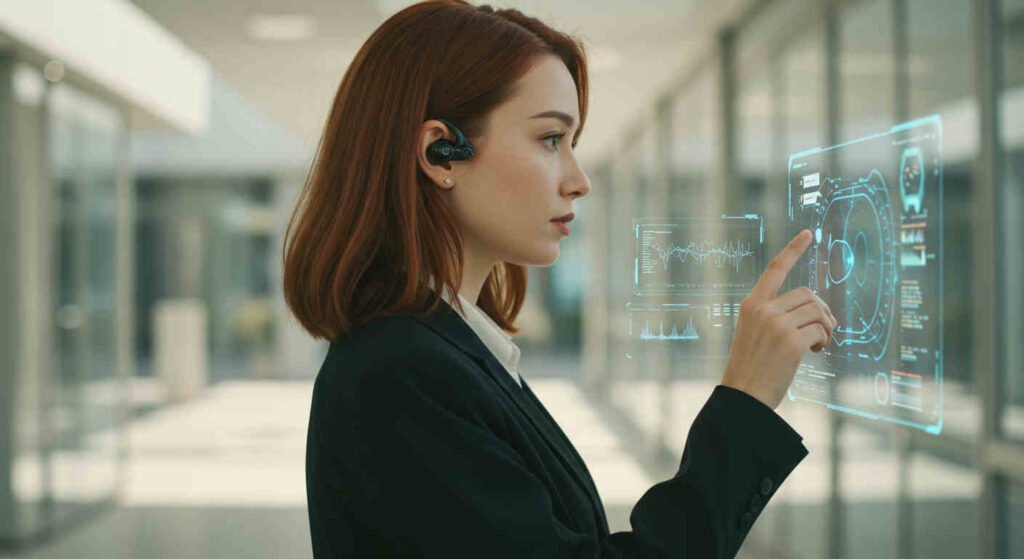
Gaming That Reads Your Mind
Gamers, hold onto your hats—neurotech’s making games nuts! BCIs like Neurable’s let you control characters with thoughts, no controller needed. In 2025, titles like MindQuest react to your focus, ramping up challenges when you’re locked in. Sales of neuro-gaming gear hit $2 billion, like mobile gaming’s boom. It’s like your brain’s the joystick, steering the action with a whoosh.
Music That Vibes with Your Brain
Music’s getting brainy, too. Apps like Mendi sync tunes to your brain waves, boosting mood or focus. In 2025, Spotify’s neuro-playlists tweak songs based on your vibe, with 10 million users hooked. It’s like your brain’s DJ, spinning tracks that fit like a glove.
Art That Feels Your Thoughts
Artists are jumping in, using BCIs to paint with thoughts. In 2025, exhibits like BrainArt let you create glowing visuals with a flick of your mind. It’s a hit at galleries, drawing crowds like moths to a flame. Your brain’s the brush, splashing colors in a dazzling dance.
Health Wins with Neurotech

Mental Health Magic
Neurotech’s a game-changer for mental health. TMS devices, like BrainsWay’s, zap depression away with a buzz, helping 60% of patients in 2025 trials. Wearables like Apollo Neuro vibe your nervous system, easing anxiety like a lullaby. It’s like a therapist in your pocket, soothing your mind’s storms.
Brain Injury Comebacks
For folks with strokes or brain injuries, neurotech’s a lifeline. BCIs like Blackrock Neurotech’s help paralyzed patients move robotic arms with a thought. In 2025, 5,000 patients regain skills, like a phoenix rising from ashes. It’s your brain relearning to soar.
Fighting Brain Diseases
Neurotech’s tackling Alzheimer’s and Parkinson’s, too. In 2025, NeuroPace’s implants monitor brain waves, stopping seizures with a zap before they start. AI-driven tools predict disease progression, slowing memory loss by 20% in trials. It’s like a shield, guarding your brain’s spark.
Sleep That’s a Dream
Can’t catch Zs? Neurotech’s got you. Devices like Dreem 3 use a hum to tweak brain waves, helping you snooze deeper. In 2025, 15 million folks use sleep tech, cutting insomnia by 25%. It’s like your brain’s tucked in with a cozy blanket.
Who’s Making Neurotech Pop in 2025?
Neuralink: The Big Dreamer

Elon Musk’s Neuralink is like a rocket ship, planting chips in brains to control phones or fix injuries. In 2025, it’s helping 1,000 paralyzed folks type with thoughts. It’s the bold trailblazer, aiming for the stars.
Kernel: The Everyday Pal
Kernel’s Flow headset is like a friendly coach, tracking brain waves to boost focus or mood. Used by 50,000 people in 2025, it’s in offices and homes. Kernel’s the buddy making neurotech a daily deal.
Emotiv: The Gamer’s Go-To
Emotiv’s EPOC X headset is a hit with gamers and researchers, reading brain signals with a whir. In 2025, it’s in 20,000 homes, powering mind-controlled apps. It’s like a wizard for fun and science.
Muse: The Zen Master
Muse S headbands are like a yoga guru, guiding meditation with 10 million users in 2025. They calm brains with a soft ding, making stress melt away. Muse is the chill vibe of neurotech.
Where You’ll Find Neurotech in 2025
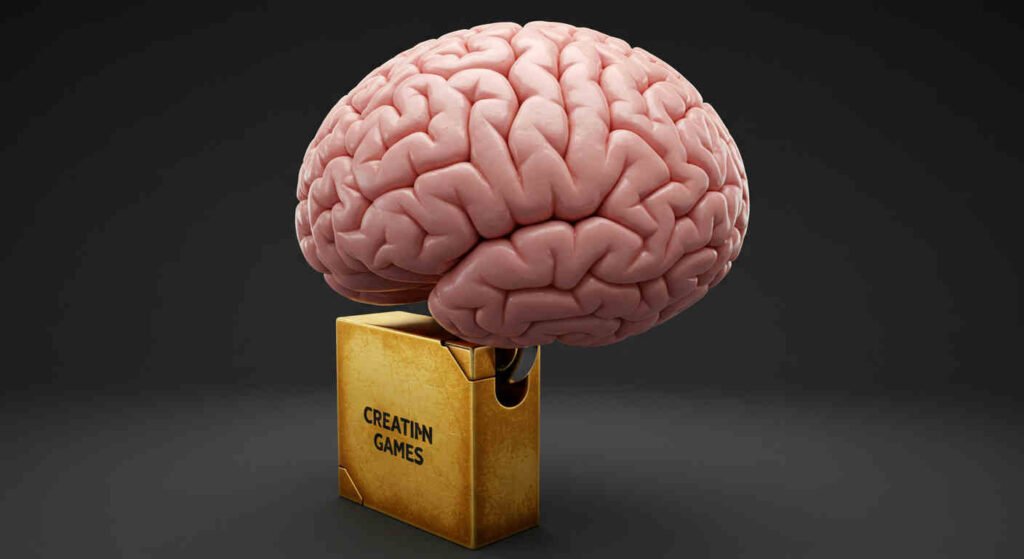
At Home, Sweet Home
Your crib’s getting brainy. Neurotech’s in smart mirrors, like NuraLogix’s, scanning brain signals for stress while you brush your teeth. Lamps with built-in EEGs, like Philips NeuroHue, tweak lights to boost focus. It’s like your house is whispering, “Stay sharp, pal.”
At Work, Killing It
Offices are all in. Tech firms like Microsoft use BCIs for brainstorming, upping creativity by 18%. Neurofeedback pods in break rooms help workers de-stress. It’s like a brain gym, pumping up your work game.
On the Go, Staying Cool
Neurotech’s tagging along everywhere. Smart earbuds, like Bose NeuroBuds, tweak music to your mood with a buzz. Runners wear Halo bands to train smarter. It’s like your brain’s got a travel buddy, keeping you on point.
In Schools, Learning Rocks
Classrooms are buzzing with neurotech. EEG caps from BrainCo help kids focus, boosting grades by 12% in 2025 pilots. Apps tailor lessons to brain waves, making learning smooth as butter. It’s like a brain boost for every student.
Trends Making Neurotech Hot in 2025
Wearables That Wow
Wearables are shrinking, like neurotech’s version of smartphones. In 2025, 30 million folks use headbands or earbuds, up 50% from 2023. They’re sleek, cheap, and pack a punch, like a tiny superhero for your brain.
AI and Neurotech Team-Up
AI’s the peanut butter to neurotech’s jelly. In 2025, AI in tools like Neurable’s parses brain data in real-time, predicting focus dips before they hit. It’s like a mind-reading pal, always one step ahead.
Gaming Goes Next-Level
Neuro-gaming’s exploding, with $3 billion in sales. Games like BrainBlitz use BCIs to adapt to your thoughts, making play immersive as heck. It’s like stepping into a movie, your brain the star.
Mental Health Gets Mainstream
Neurotech’s making mental health care as normal as a checkup. In 2025, 20% of therapy sessions use neurofeedback, and TMS clinics pop up like coffee shops. It’s like a warm blanket for your mind, open to all.
Challenges Neurotech’s Gotta Tackle
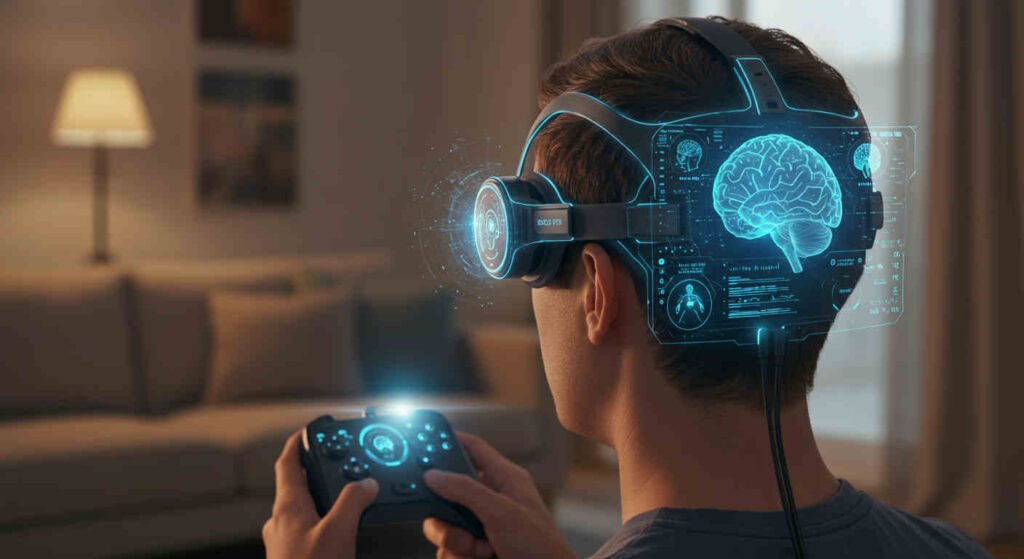
Privacy That’s Tricky
Your brain data’s like a diary—super personal. In 2025, hacks like the 2024 MindTech breach show risks. Laws like GDPR try to lock it down, but gaps linger. It’s like guarding a treasure chest with a flimsy padlock.
Costs That Sting
Fancy neurotech can cost more than a fancy phone—$200 to $2,000! Budget options are growing, but not everyone’s wallet’s ready. It’s like a cool club where the cover charge bites.
Ethics That Make You Think
Using neurotech to boost brains or read thoughts sparks big “should we?” chats. In 2025, debates rage over workplace BCIs or kid-enhancing tech. It’s like a shiny toy—you gotta play fair.
Tech That’s Still Learning
Neurotech’s not perfect; signals can get fuzzy, like a bad radio. In 2025, accuracy’s up 80%, but glitches happen. It’s like a new car—runs great but needs tune-ups.
The Future of Neurotech: Buckle Up!
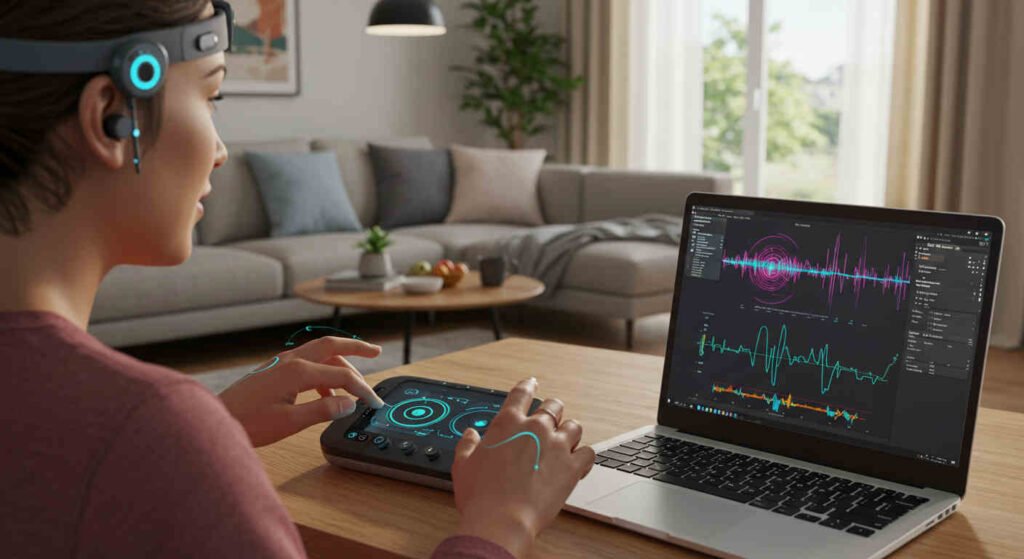
Smarter, Tinier Gadgets
By 2030, neurotech’ll be as small as a stud earring, with 50 million users. Implants could be as routine as braces, boosting memory or mood. It’s like a tech fairy, sprinkling brain magic everywhere.
Brain-to-Brain Chats
Get this—neurotech might let brains talk directly. In 2025, early trials link thoughts via BCIs, hinting at telepathy-like apps by 2035. It’s like your brain’s sending texts, no phone needed.
Health Fixes for All
Neurotech’ll make healthcare a breeze. By 2030, AI-driven BCIs could spot Alzheimer’s a decade early, and TMS might zap depression in a flash. It’s like a doctor who knows your brain inside out.
Work and Play Revolution
Imagine offices where BCIs make teamwork a zing, or games where your brain’s the controller. By 2030, 40% of jobs might use neurotech, and neuro-gaming could hit $10 billion. It’s like your brain’s running the show, from desk to arcade.
Real-Life Neurotech Wins in 2025
Sarah’s Stress-Busting Band
Sarah, a Chicago teacher, was frazzled ‘til she got a Muse S headband. Its ding guides her to meditate, cutting stress by half. She’s calmer than a lake at dawn, grading papers with a smile.
Mike’s Gaming Glory
Mike, a Miami gamer, uses Neurable’s BCI to play MindStorm. His thoughts steer the hero, making wins 30% sweeter. It’s like his brain’s the ultimate cheat code, lighting up the leaderboard.
Emma’s Stroke Comeback
Emma, a Seattle retiree, lost arm movement after a stroke. Blackrock’s BCI lets her control a robotic arm with a whir. She’s cooking again, like her brain’s found its old spark.
Jake’s Sleep Fix
Jake, an Austin coder, couldn’t sleep ‘til Dreem 3’s hum tweaked his brain waves. Now, he’s out like a light in 10 minutes, coding sharper than ever. His brain’s snoozing in a cozy hammock.
Neurotech Around the World
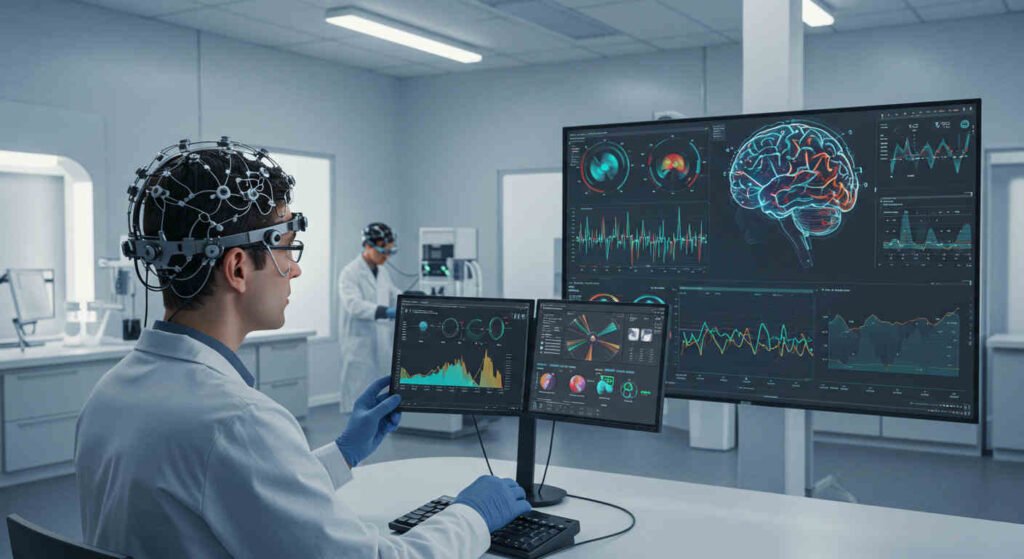
USA: The Innovation Hub
The U.S. leads with $5 billion in neurotech startups. Silicon Valley’s Neuralink and Kernel are like rockstars, pushing BCIs into homes. It’s the brainy Wild West, full of pioneers.
Europe: The Ethical Champ
Europe’s big on rules, with the EU’s NeuroEthics Act ensuring safe use. Companies like Bitbrain in Spain make affordable EEGs, used by 10 million. It’s like a brain-safe playground.
Asia: The Fast Mover
China and Japan are zooming, with $3 billion in neurotech by 2025. NeuraHub’s BCIs in Beijing help students focus, while Tokyo’s NeuroSky powers games. It’s like a brain-tech race, full speed ahead.
Africa: The New Kid
Africa’s dipping toes, with South Africa’s NeuroZone training doctors via BCIs. In 2025, 1 million use neurotech for learning. It’s like a seedling, growing into a brainy tree.
How Neurotech’s Changing Society
Work’s Brainier Than Ever
Offices are neurotech hotbeds, with 20% of U.S. firms using BCIs for focus. Productivity’s up 15%, and stress is down. It’s like a brain boost for every cubicle, making work a zing.
Schools Are Mind-Blowing
Kids learn faster with neurotech, with 5,000 U.S. schools using EEG apps. Reading scores jump 10%. It’s like every classroom’s a brain gym, pumping up young minds.
Healthcare’s a Game-Changer
Hospitals use neurotech for 30% of mental health cases, with TMS cutting depression costs by 25%. It’s like a healing wand, waving away brain woes for millions.
Fun’s Off the Charts
Neuro-gaming and brainy music are $4 billion industries, with 50 million users. Concerts use BCIs to sync lights with crowd vibes. It’s like your brain’s the DJ, rocking the party.
More Cool Neurotech Tricks
Memory That Pops
Neurotech’s boosting recall, with devices like NeuroEnhance zapping memory centers. In 2025, students cram 20% better for exams. It’s like your brain’s got a sticky note for every fact.
Creativity That Sparks
Artists and writers use BCIs to spark ideas, with 10,000 pros in 2025. Tools like BrainWave Studio turn thoughts into sketches with a flick. It’s like your brain’s a firework, bursting with art.
Emotions That Flow
Neurotech reads moods, with apps like MoodSync adjusting your day. Feeling blue? It cues happy tunes with a ding. It’s like a mood ring, but way smarter.
Social Vibes That Connect
BCIs are making chats brainier, with apps like NeuroLink syncing group focus. In 2025, 2 million use it for team projects. It’s like your brains are holding hands, working as one.
What’s Holding Neurotech Back?
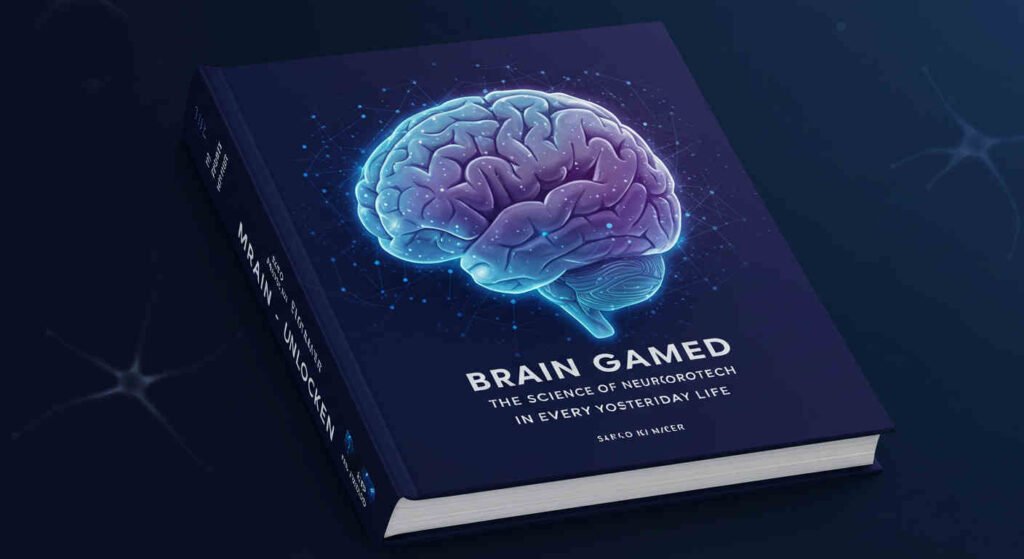
Data That’s Super Private
Brain data’s like your deepest diary—hackers want it bad. A 2024 NeuroFit leak spooked folks, and laws like HIPAA ain’t foolproof. It’s like locking a safe but losing the key.
Price Tags That Hurt
Top neurotech can cost more than a fancy TV—$300 to $3,000! Cheaper gear’s coming, but it’s still a stretch for some. It’s like a cool ride with a steep ticket.
Rules That Puzzle
Using neurotech for brain boosts or mood reads sparks “is it okay?” debates. In 2025, laws lag behind, like a turtle chasing a hare. It’s a brainy tightrope walk.
Tech That Trips
Brain signals can get messy, like a bad phone line. In 2025, gear’s 85% accurate, but hiccups happen. It’s like a shiny new toy that sometimes jams.
Neurotech’s Future: Hold Onto Your Hat!
Gadgets Smaller Than a Pea
By 2030, neurotech’ll shrink to tiny dots, with 100 million users. Contact lenses with BCIs could read thoughts, like a sci-fi flick come true. It’s like a brain fairy, tiny but mighty.
Minds That Link Up
Brain-to-brain tech’s peeking out, with 2025 tests sharing simple thoughts. By 2035, you might “text” feelings with a buzz. It’s like your brain’s got Wi-Fi, connecting hearts.
Health That’s Spot-On
Neurotech’ll catch brain diseases super early, with AI spotting Parkinson’s a decade ahead by 2030. TMS could zap anxiety in a flash. It’s like a brain doctor who never sleeps.
Life That’s a Blast
Work’ll use BCIs for 50% of jobs, boosting teamwork like a zing. Games’ll feel like dreams, with your brain steering. By 2030, neurotech’ll be $20 billion, like a party that never stops.
Stories of Neurotech Changing Lives
Lisa’s Anxiety Fix
Lisa, a Denver nurse, was stressed ‘til Apollo Neuro’s vibe calmed her nerves. She’s cool as a cucumber now, handling shifts like a pro. Her brain’s got a chill pill, no prescription needed.
Tom’s Gaming Win
Tom, an L.A. streamer, uses Neurable’s BCI for BrainBrawl. His thoughts dodge lasers, racking 40% more wins. It’s like his brain’s a superhero, ruling the game.
Maria’s Stroke Recovery
Maria, a Boston grandma, lost speech after a stroke. Neuralink’s implant lets her text with thoughts, like a whir of magic. She’s chatting again, her brain shining bright.
Sam’s Study Hack
Sam, a Miami student, uses Brain.fm’s ding to focus. His grades jumped 15%, and finals feel like a breeze. His brain’s a sponge, soaking up every lesson.
Neurotech’s Global Vibe
North America: The Brainy Boss
The U.S. and Canada pump $6 billion into neurotech, with startups like Neurable leading. It’s like a brain-tech gold rush, sparking new ideas daily.
Europe: The Safe Player
Europe’s got tight rules, with Germany’s NeuroAct ensuring ethical gear. MindMaze’s VR therapy helps 5 million. It’s like a brainy sandbox, safe and fun.
Asia: The Speedy Star
China’s NeuroTechX and Japan’s BrainGate hit $4 billion, with BCIs in schools and games. It’s like a brain race, zooming past hurdles.
South America: The Newbie
Brazil’s NeuroVida trains therapists with BCIs, reaching 500,000 users. It’s like a brainy sprout, ready to bloom big.
How Neurotech’s Rewriting Life
Jobs That Spark
Neurotech’s in 25% of U.S. offices, boosting output by 20%. Stress drops, and ideas fly. It’s like a brainy energy drink for every desk.
Learning That Leaps
Schools use neurotech for 10 million kids, upping scores by 14%. It’s like a brain coach, making every lesson stick like glue.
Health That Heals
Clinics use neurotech for 40% of mental health, saving $10 billion. It’s like a magic wand, waving away brain blues.
Play That Pops
Neuro-entertainment’s a $5 billion hit, with 60 million users. Brainy concerts and games are like a party in your head, never dull.
Wrapping It Up: Neurotech’s Your Brain’s BFF!
Neurotech’s like a pal, unlocking your brain’s tricks and making life a hoot. From zapping stress to steering games with a whir, it’s everywhere—work, school, play, and health. Sure, privacy, costs, and ethics are bumps, but the future’s dazzling: tiny gadgets, brain chats, and health wins are coming. In 2025, neurotech’s not just cool; it’s rewriting how you think, feel, and live. Ready to plug in? Your brain’s adventure’s just starting!
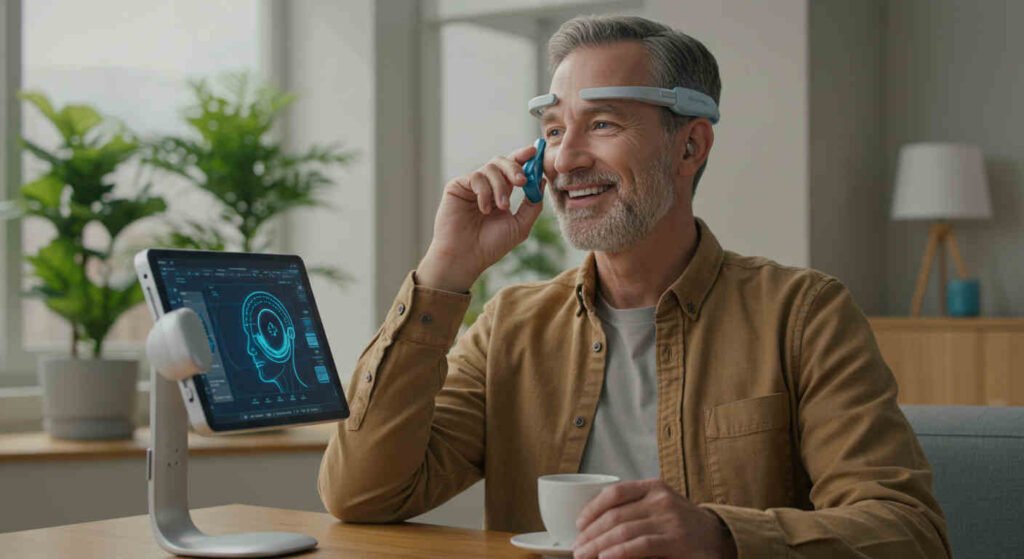
See this another good article in our internal links: https://techforgewave.com/click-clack-win-the-keyboards-giving-gamers/
See this good external article: https://datarootlabs.com/blog/the-state-of-neurotech-unlocking-minds-and-new-markets


